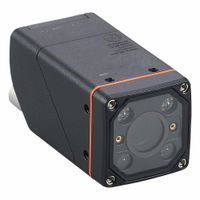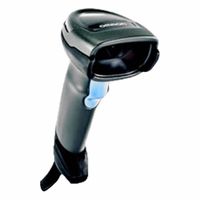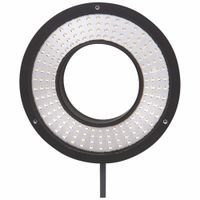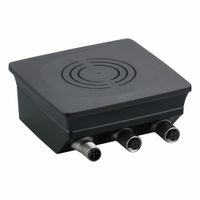Call +(254) 703 030 000 / 751 483 999 / 721 704 777
- Home
- Electrical
- Industrial Controls Automation And Machine Safety
- Proximity Motion Vision Sensors
- Vision Sensors Code Readers
.....Read More
Frequently Asked Questions
What are the key differences between vision sensors and code readers?
Vision sensors are devices that capture and process images to make decisions based on visual data. They are used for tasks like object detection, presence verification, and quality inspection. Vision sensors can handle complex tasks by analyzing various attributes such as shape, size, color, and orientation. They often incorporate image processing algorithms to interpret the captured data and provide feedback or trigger actions based on the analysis.
Code readers, on the other hand, are specialized devices designed to read and decode barcodes, QR codes, and other types of machine-readable symbols. They focus on extracting encoded information from these symbols, which can include product details, serial numbers, or URLs. Code readers are optimized for speed and accuracy in decoding, often using laser or imaging technology to capture the code and software algorithms to interpret it.
Key differences include:
1. **Functionality**: Vision sensors perform a wide range of tasks involving image analysis, while code readers are specifically designed to decode symbols.
2. **Complexity**: Vision sensors handle more complex image processing tasks, whereas code readers focus on the simpler task of decoding.
3. **Applications**: Vision sensors are used in quality control, object recognition, and automation, while code readers are used in inventory management, point-of-sale systems, and logistics.
4. **Technology**: Vision sensors use advanced imaging and processing technologies, while code readers use laser or imaging technology optimized for reading codes.
5. **Output**: Vision sensors provide detailed analysis and decision-making outputs, while code readers output decoded information from symbols.
In summary, vision sensors offer broader capabilities in image analysis, while code readers are specialized for decoding machine-readable symbols.
How do handheld industrial multicode readers work in inventory management?
Handheld industrial multicode readers are essential tools in inventory management, designed to scan and decode various types of barcodes and QR codes. These devices use advanced imaging technology, typically involving a camera and a decoding algorithm, to capture and interpret the encoded data on labels attached to inventory items.
When a multicode reader is pointed at a barcode or QR code, it emits a light source, often a laser or LED, to illuminate the code. The device's camera captures the reflected light, creating an image of the code. The onboard processor then analyzes this image using pattern recognition software to decode the information, which usually includes product details like SKU, batch number, and location.
These readers support multiple code formats, such as 1D barcodes (e.g., UPC, EAN) and 2D codes (e.g., QR codes, Data Matrix), making them versatile for various inventory systems. The decoded data is transmitted wirelessly or via a wired connection to a central inventory management system, updating stock levels in real-time.
In inventory management, handheld multicode readers streamline processes by enabling quick and accurate data capture, reducing human error associated with manual entry. They facilitate efficient stocktaking, order picking, and goods receiving, ensuring that inventory records are up-to-date. This real-time data integration helps in maintaining optimal stock levels, preventing overstocking or stockouts, and improving overall supply chain efficiency.
Additionally, these devices are often ruggedized to withstand harsh industrial environments, ensuring durability and reliability. Their portability allows workers to move freely within warehouses or storage facilities, enhancing operational flexibility and productivity.
What are the benefits of using fixed-location vision sensors in manufacturing?
Fixed-location vision sensors in manufacturing offer several benefits:
1. **Consistency and Accuracy**: These sensors provide consistent and accurate inspection, reducing human error and ensuring high-quality standards.
2. **Increased Efficiency**: By automating inspection processes, they speed up production lines, minimizing downtime and increasing throughput.
3. **Cost Reduction**: They reduce labor costs by minimizing the need for manual inspection and rework due to defects.
4. **Real-time Monitoring**: Fixed-location sensors offer real-time data and analytics, allowing for immediate detection and correction of defects.
5. **Improved Quality Control**: They ensure that products meet specifications by detecting defects, misalignments, or deviations early in the production process.
6. **Enhanced Safety**: By automating inspection tasks, they reduce the need for human intervention in potentially hazardous environments.
7. **Scalability**: These systems can be easily scaled to accommodate changes in production volume or product design.
8. **Traceability**: They provide detailed records of inspections, aiding in traceability and compliance with industry standards.
9. **Flexibility**: Modern vision sensors can be programmed to inspect a wide range of products and features, adapting to different manufacturing needs.
10. **Integration with Other Systems**: They can be integrated with other automation systems, enhancing overall production line efficiency.
11. **Reduced Waste**: By catching defects early, they help in reducing material waste and improving resource utilization.
12. **Predictive Maintenance**: Data from vision sensors can be used for predictive maintenance, reducing unexpected equipment failures.
Overall, fixed-location vision sensors enhance productivity, quality, and safety in manufacturing environments.
How do RFID sensors and tags improve tracking in production and storage?
RFID sensors and tags enhance tracking in production and storage by providing real-time visibility and automation. RFID tags, which contain microchips and antennas, are attached to products or containers. These tags store data about the items, such as identification numbers, location, and status. RFID readers, or sensors, emit radio waves to communicate with the tags, capturing the stored data without requiring line-of-sight, unlike barcodes.
In production, RFID enables precise tracking of materials and components throughout the manufacturing process. This ensures accurate inventory management, reduces errors, and minimizes delays. Automated data collection speeds up processes, as items are scanned in bulk rather than individually. This leads to improved efficiency and reduced labor costs.
In storage, RFID provides real-time inventory visibility, allowing for accurate stock levels and location tracking. This reduces the risk of overstocking or stockouts and enhances order fulfillment accuracy. RFID systems can trigger alerts for misplaced items or unauthorized movements, improving security and reducing losses.
RFID also supports advanced analytics, enabling better demand forecasting and resource planning. By analyzing RFID data, companies can optimize production schedules, reduce waste, and improve supply chain efficiency.
Overall, RFID technology streamlines operations, enhances accuracy, and provides valuable insights, leading to improved productivity and cost savings in production and storage environments.
What role do illumination units play in enhancing multicode reader performance?
Illumination units are crucial in enhancing multicode reader performance by providing consistent and optimal lighting conditions, which are essential for accurate code detection and decoding. They ensure that the codes are evenly lit, reducing shadows and reflections that can obscure code elements. This uniform lighting enhances the contrast between the code and its background, making it easier for the reader to distinguish the code's features.
Different types of illumination, such as bright field, dark field, and diffuse lighting, can be used depending on the surface characteristics of the object being scanned. For instance, bright field illumination is effective for flat, matte surfaces, while dark field illumination is better suited for shiny or reflective surfaces. Diffuse lighting helps in minimizing glare and reflections, which can interfere with code readability.
Moreover, illumination units can be adjusted in terms of intensity and angle to accommodate various environmental conditions and code types. This adaptability is vital for reading codes on diverse materials and surfaces, such as metal, plastic, or glass, and in different ambient lighting conditions.
Advanced illumination units also incorporate technologies like LED lighting, which offers high brightness, low power consumption, and long lifespan, further enhancing the reliability and efficiency of multicode readers. By providing the right lighting conditions, illumination units help in reducing read errors, increasing read rates, and improving overall system performance, especially in high-speed and high-volume applications.
In summary, illumination units play a pivotal role in optimizing the performance of multicode readers by ensuring that codes are clearly visible and distinguishable, thereby facilitating accurate and efficient code reading across various applications and environments.
How can sensor mounting systems improve the accuracy of electrical sensors?
Sensor mounting systems can significantly enhance the accuracy of electrical sensors by ensuring optimal positioning, stability, and environmental protection. Proper mounting minimizes mechanical vibrations and external interferences, which can introduce noise and errors in sensor readings. By securing the sensor in a fixed position, the mounting system ensures consistent alignment with the target measurement area, reducing positional errors and improving repeatability.
Additionally, mounting systems can incorporate materials and designs that dampen vibrations and isolate the sensor from mechanical shocks. This isolation is crucial in environments with heavy machinery or fluctuating conditions, where vibrations can skew sensor data.
Environmental protection is another critical factor. Mounting systems can shield sensors from dust, moisture, and temperature fluctuations, which can affect sensor performance and longevity. By maintaining a stable micro-environment around the sensor, the mounting system helps maintain calibration and accuracy over time.
Furthermore, mounting systems can facilitate easy calibration and maintenance. By allowing for quick sensor removal and reinstallation without altering the sensor's position or orientation, these systems ensure that recalibration or repairs do not introduce new errors.
In summary, sensor mounting systems improve the accuracy of electrical sensors by providing stability, reducing environmental interferences, and ensuring consistent sensor positioning. This leads to more reliable and precise measurements, essential for applications requiring high accuracy.
What applications benefit most from optical distance switches in automation?
Optical distance switches, also known as photoelectric sensors, are crucial in automation for their precision, speed, and non-contact operation. They are particularly beneficial in the following applications:
1. **Manufacturing and Assembly Lines**: Optical distance switches are used for object detection, counting, and positioning. They ensure components are correctly placed and aligned, enhancing quality control and reducing waste.
2. **Material Handling and Logistics**: In conveyor systems, these sensors detect the presence and position of packages, enabling efficient sorting and routing. They help in maintaining flow and preventing jams.
3. **Automotive Industry**: Used in robotic arms and automated assembly, optical sensors ensure precise placement of parts and monitor the presence of components, crucial for maintaining production accuracy and safety.
4. **Packaging Industry**: They detect the presence and position of products and packaging materials, ensuring correct labeling, filling, and sealing processes.
5. **Food and Beverage Industry**: Optical sensors are used for level detection in containers and monitoring the presence of bottles and cans on production lines, ensuring hygiene and efficiency.
6. **Pharmaceutical Industry**: They ensure the correct placement and counting of pills and vials, crucial for compliance with health regulations and quality assurance.
7. **Textile Industry**: Optical distance switches monitor fabric alignment and detect defects, ensuring consistent quality and reducing material waste.
8. **Robotics**: In autonomous robots, these sensors provide spatial awareness, enabling navigation and obstacle avoidance.
9. **Safety Systems**: Optical sensors are used in safety light curtains and barriers, protecting workers by detecting intrusions into hazardous areas.
10. **Agriculture**: They are used in automated systems for monitoring crop levels and detecting obstacles in autonomous farming equipment.
Overall, optical distance switches enhance efficiency, accuracy, and safety across various industries, making them indispensable in modern automation systems.





